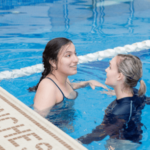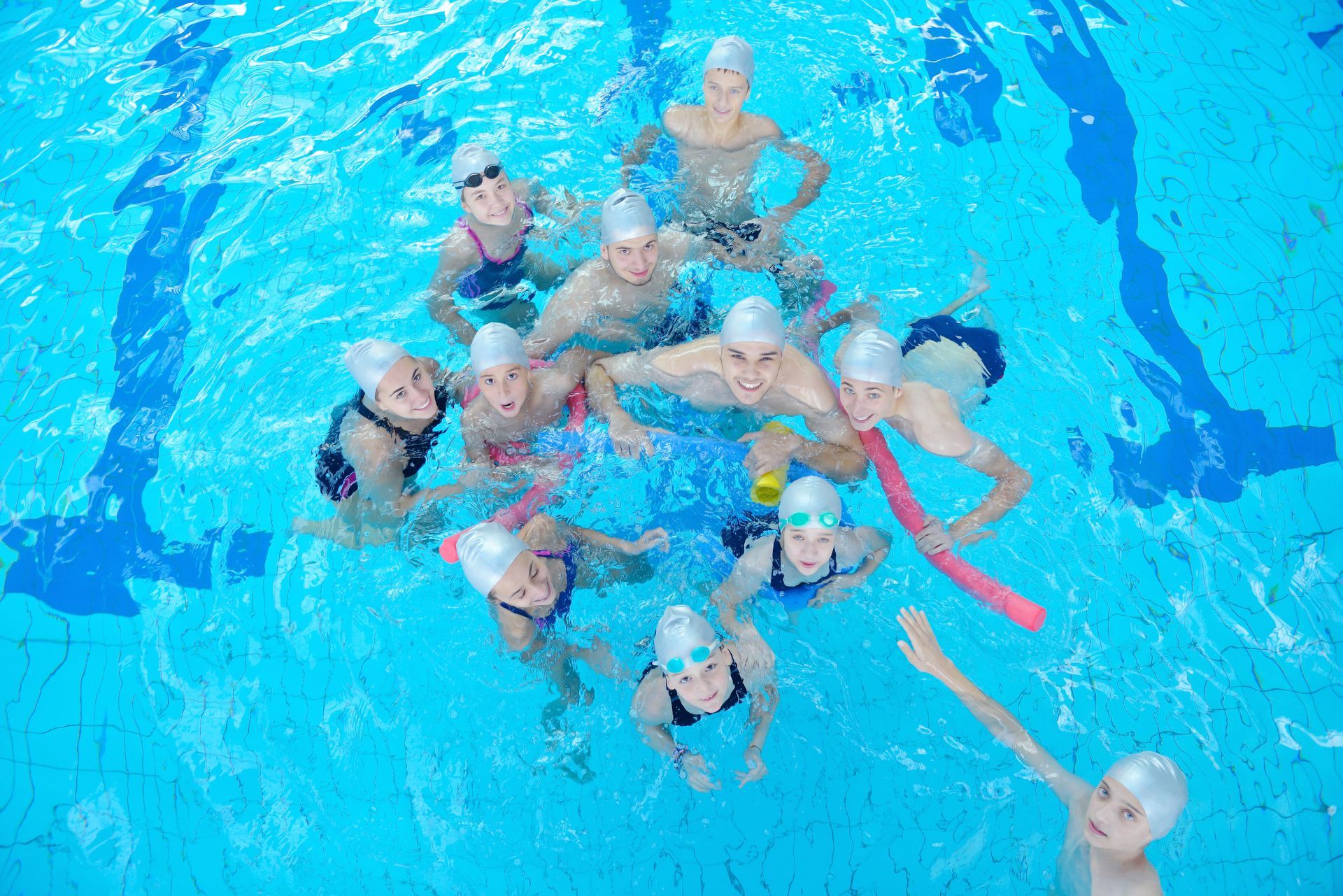Honoring our students for Autism Awareness Month

The month of April is National Autism Awareness Month. The Autism Society notes “National Autism Awareness Month is an excellent opportunity to promote autism spectrum disorder (ASD) awareness, autism acceptance and to draw attention to the tens of thousands facing an ASD diagnosis each year.” SwimJim has always been a dedicated advocate for creating an inclusive class environment for our students with autism spectrum disorders through love, acceptance and appreciation. The benefits of swimming for students with ASD are many. First and foremost, the crucial water safety aspects are even more important for these particular students. Additionally, the physical and social aspects of swim lessons assist in their progressive development.
To understand why it is so crucial that all children with ASD learn to swim, despite the challenges involved, you have to first look at the facts:
- About 1 percent of the world population has autism spectrum disorder. ( CDC, 2014 )
- Prevalence of autism in U.S. children increased by 119.4 percent from 2000 (1 in 150) to 2010 (1 in 68). ( CDC, 2014 )
- Autism is the fastest-growing developmental disability. ( CDC, 2008 )
- A child can drown in the time it takes to answer the phone. (US Consumer Product Safety Commission)
- Children under the age of five and adolescents between the ages of 15 to 24 have the highest drowning rates. For every child who drowns, four other are hospitalized for non-fatal drownings. (American Academy of Pediatrics)
- Tragically, children and adults with autism are often attracted to water sources such as pools, ponds, and lakes. Drowning is the leading cause of death for a child or adult who has autism. (National Autism Society)
- Between 2009 and 2011, accidental drowning accounted for 91 percent of the total U.S. deaths reported in children with autism ages 14 and younger who had wandered away from their homes, schools, or caregivers. (National Autism Society)
 Leading into Autism Awareness Month, we sat down with some SwimJim families impacted by ASD and hear about what swim lessons mean to them. When asked why her child, Mikey, should learn how to swim, Sheryl responded, “I have a strong belief that every child needs to learn to swim for safety. This is even more importantt for Mikey with his limited receptive and expressive language as there is a great fear he will not understand dangers or be able to call out for help if he is in a dangerous situation. I also hope for a secondary benefit for Mikey in the sensory input the water offers him, as he tends to be under reactive and needs extra stimulation. This also makes the safety issue more imperative as he is drawn to water.” Children with ASD typically have limited inherent sense of danger or threats and like most people, they have a true affinity for the water. When you put those two things together the risk of a drowning incident dramatically increases. That is why it is imperative to teach children with ASD to swim.
Leading into Autism Awareness Month, we sat down with some SwimJim families impacted by ASD and hear about what swim lessons mean to them. When asked why her child, Mikey, should learn how to swim, Sheryl responded, “I have a strong belief that every child needs to learn to swim for safety. This is even more importantt for Mikey with his limited receptive and expressive language as there is a great fear he will not understand dangers or be able to call out for help if he is in a dangerous situation. I also hope for a secondary benefit for Mikey in the sensory input the water offers him, as he tends to be under reactive and needs extra stimulation. This also makes the safety issue more imperative as he is drawn to water.” Children with ASD typically have limited inherent sense of danger or threats and like most people, they have a true affinity for the water. When you put those two things together the risk of a drowning incident dramatically increases. That is why it is imperative to teach children with ASD to swim.
Other than safety, there are many other benefits in a child with ASD learning to swim. “The hydrostatic pressure (water surrounding the body), turbulence (movement of the water) and viscosity (the thickness of the water) are all properties of water which help to aid a person with sensory awareness challenges and autism spectrum disorders. When the body is submerged in the water, the hydrostatic pressure is very calming for the students… Water can also help to improve fine and gross motor movement, coordination, independence, attention span, language development, as well as be a way for children to learn the hazards in and around the aquatic environment.” (Swimming with Autism)
Karl and Marie, parents of Jason say, “The benefits [of Jason learning how to swim] are multiple. Jason learns how to interact with people in a new setting, how to follow  directions, and how to gain greater control over his body. It is a healthy form of exercise that seems to leave him much calmer afterwards. I like to think, too, that it gives him a feeling of accomplishment as he makes slow but steady progress in his swimming. It also gives us something that we can do together as a family and that Jason can do with his cousins and friends. Besides the therapeutic reasons discussed above, it is also important to us that Jason knows how to be safe in the water. Like many autistic children, he is drawn to water, and we want to make sure that if he were to fall in to a pool or pond, he would know how to swim, even in water over his head.”
directions, and how to gain greater control over his body. It is a healthy form of exercise that seems to leave him much calmer afterwards. I like to think, too, that it gives him a feeling of accomplishment as he makes slow but steady progress in his swimming. It also gives us something that we can do together as a family and that Jason can do with his cousins and friends. Besides the therapeutic reasons discussed above, it is also important to us that Jason knows how to be safe in the water. Like many autistic children, he is drawn to water, and we want to make sure that if he were to fall in to a pool or pond, he would know how to swim, even in water over his head.”
Through learning to swim we can accomplish what other believe to be impossible. We do not set limits for our students with ASD. Instead, we set up goals and push these students to challenge themselves a little more each week. As a result, they are able achieve greater things and surpass more milestones. With the SwimJim Team’s hard work and dedication to our students with autism spectrum disorders we are able to teach those students a lifesaving skill.
 Esther, who has three children, one with ASD says, “The most important benefit of knowing how to swim — for Natasha and for my other two children — is safety. To me, knowing how to swim is a necessary life skill for being safe around water. Swimming also brings Natasha health benefits. It keeps her active and athletic and gives her great, effective, regular exercise. For Natasha in particular, as a person with autism, learning to put together the steps necessary to do the crawl, the backstroke, the elementary backstroke, to dive is important to her general ability to learn to follow instructions, to repeat and string together steps and to connect with people in different environments. If my main goals were safety and exercise when I first started Natasha in lessons (she was four months old then, and showed no signs of autism), I continue them for those reasons and because swimming makes her happy. Period. She loves being in the water and being a swimmer. And swimming brings her peace, a sense of calm and a clear sense of accomplishment. What more could I ask for?”
Esther, who has three children, one with ASD says, “The most important benefit of knowing how to swim — for Natasha and for my other two children — is safety. To me, knowing how to swim is a necessary life skill for being safe around water. Swimming also brings Natasha health benefits. It keeps her active and athletic and gives her great, effective, regular exercise. For Natasha in particular, as a person with autism, learning to put together the steps necessary to do the crawl, the backstroke, the elementary backstroke, to dive is important to her general ability to learn to follow instructions, to repeat and string together steps and to connect with people in different environments. If my main goals were safety and exercise when I first started Natasha in lessons (she was four months old then, and showed no signs of autism), I continue them for those reasons and because swimming makes her happy. Period. She loves being in the water and being a swimmer. And swimming brings her peace, a sense of calm and a clear sense of accomplishment. What more could I ask for?”
The post Honoring our students for Autism Awareness Month appeared first on Swim Jim.







